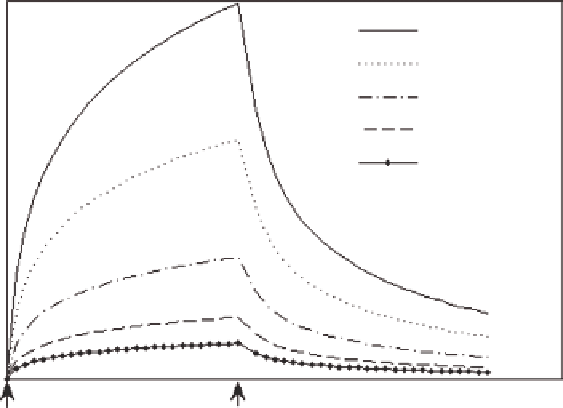Biomedical Engineering Reference
In-Depth Information
converted into heat. The former is a combined effect of the ini-
tial wave amplitude and of how much attenuation has occurred
to that point in the path of the beam. Scattering of the beam
within the body is dependent on the tissue structure and on the
incident speed of sound (Hynynen 1986). Absorption depends
on the ultrasound frequency and the intensity, which is a func-
tion of pressure amplitude (
p
), density (ρ), and acoustic imped-
ance (
Z
). Equation 5.19 describes the instantaneous intensity (
I
)
approximation for a plane wave case, although spatial and tem-
poral averaging is required to relate this quantity to the energy
absorbed in bulk within a volume.
may be very different. This implies that scatter plays a large
part in the loss of ultrasound power with distance, with quoted
absorption coefficient to attenuation coefficient ratios spanning
a range of 0.22-0.43 at 1 MHz in different tissue types (Goss et
al. 1979). It should also be noted that absorption increases with
frequency, and thus nonlinearities in the acoustic field increase
heating due to the higher harmonic content, as described in
Section 5.3.
5.4.1.1 thermal Index
One way to approach the issue of thermal effects of ultrasound
on tissues is through a quantity known as the thermal index
(TI). TI as a concept was developed by the National Council
of Radiation Protection and Measurements (Duck 2008) and
relates primarily to the safety of diagnostic levels of ultrasound.
Its definition is based on thermal models of ultrasound fields in
tissue. It is defined as the ratio of the total acoustic power to the
power required to heat tissue by 1°C (AIUM and NEMA 1992).
Three different models exist for the thermal index, depending
on the structures through which the beam is propagating. In its
simplest form, the soft tissue thermal index, TIS, can be calcu-
lated from Equation 5.20:
2
=
p
Z
I
.
(5.19)
Different intensity definitions are described in Section 5.5.2.
Although the precise mechanisms for the transfer of acoustic
energy from motion to heat are not fully understood, the domi-
nant processes can be described broadly in the following way:
as an ultrasound pressure field propagates, it causes motion of
particles during the compressional and rarefactional phases. In
the presence of a low-frequency wave causing gradual pressure
changes, tissues will respond in phase, with molecules moving
reversibly from regions of high to low density. Increasing the
frequency leads to more rapid density fluctuations, and the tis-
sue response becomes out of phase with the incident pressure
changes. The motion of molecules and tissue inhomogene-
ities relative to their surroundings results in viscous heating.
Subsequent dissipation of this heat causes an overall bulk tem-
perature rise in the exposed tissue (Bamber 1986).
Figure 5.8 shows the shape of a typical temperature profile
with time at different incident spatial peak, temporal average
intensities in an absorbing medium during HIFU heating.
An extensive study by Goss et al. has shown that absorption
and attenuation coefficients of many tissue types exhibit the
same relationship with frequency, but that their magnitudes
fW
c
01
(5.20)
TIS
=
210
where
f
c
is the center working frequency of the transducer, and
W
01
is the power as measured through a 1-cm aperture. Two
more complex indices are also defined: the TIB, used when there
is an interface with bone somewhere close to the focus of the
beam, for example, when imaging a fetus; and the TIC, used
when bone lies close to the surface of the transducer, such as
during cranial ultrasound. Detailed discussion of these is out-
side the scope of this text, however measurements relating to the
above quantities are introduced in Section 5.5. Although the TI
is not used routinely when discussing therapeutic ultrasound
1500 W/cm
2
750 W/cm
2
370 W/cm
2
180 W/cm
2
90 W/cm
2
HIFU off
HIFU on
FIGURE 5.8
Temperature as a function of time at the peak of a focused ultrasound field, and its variation with peak intensity.



